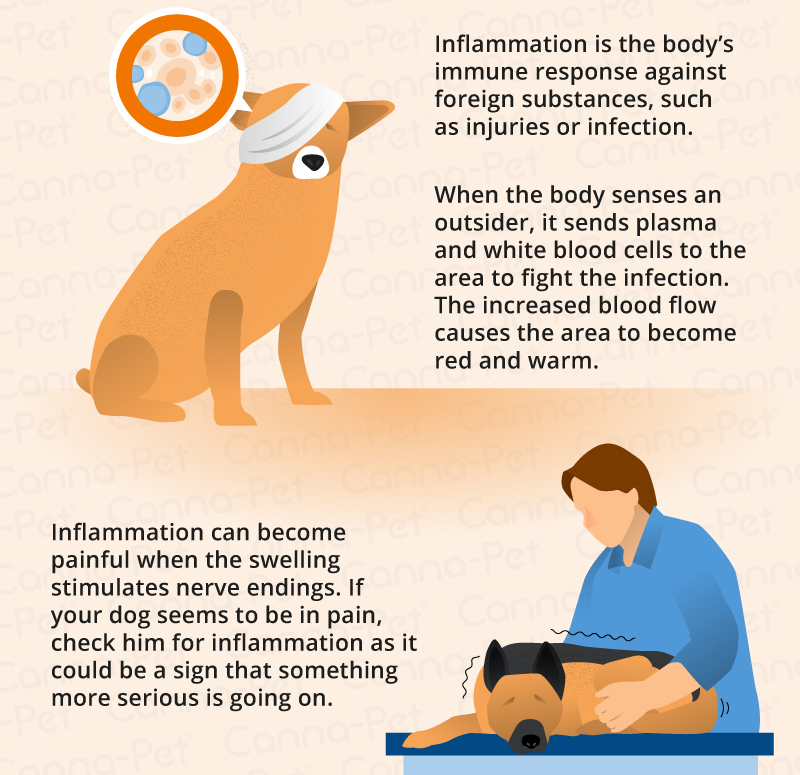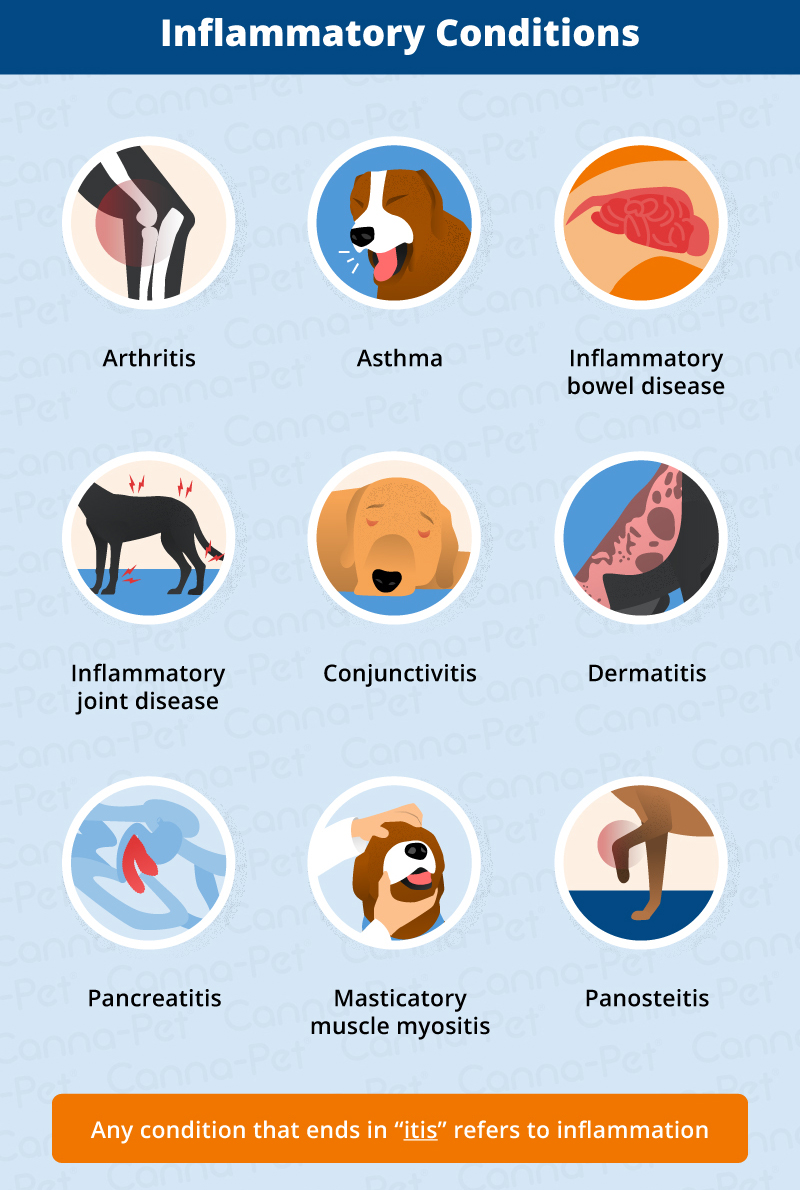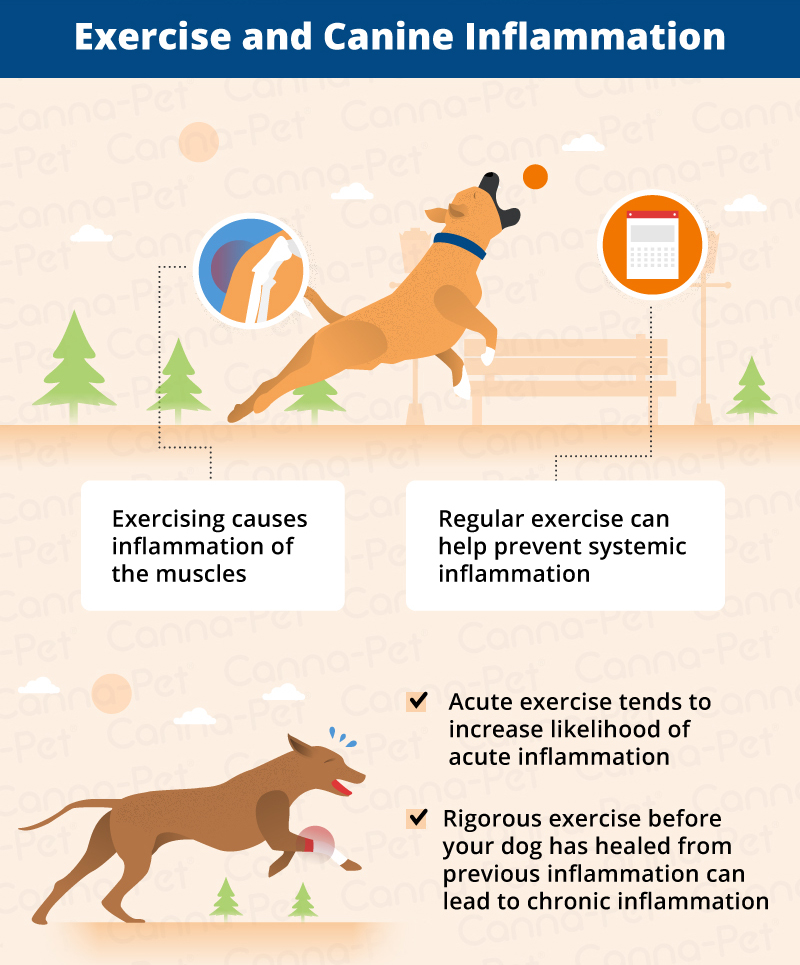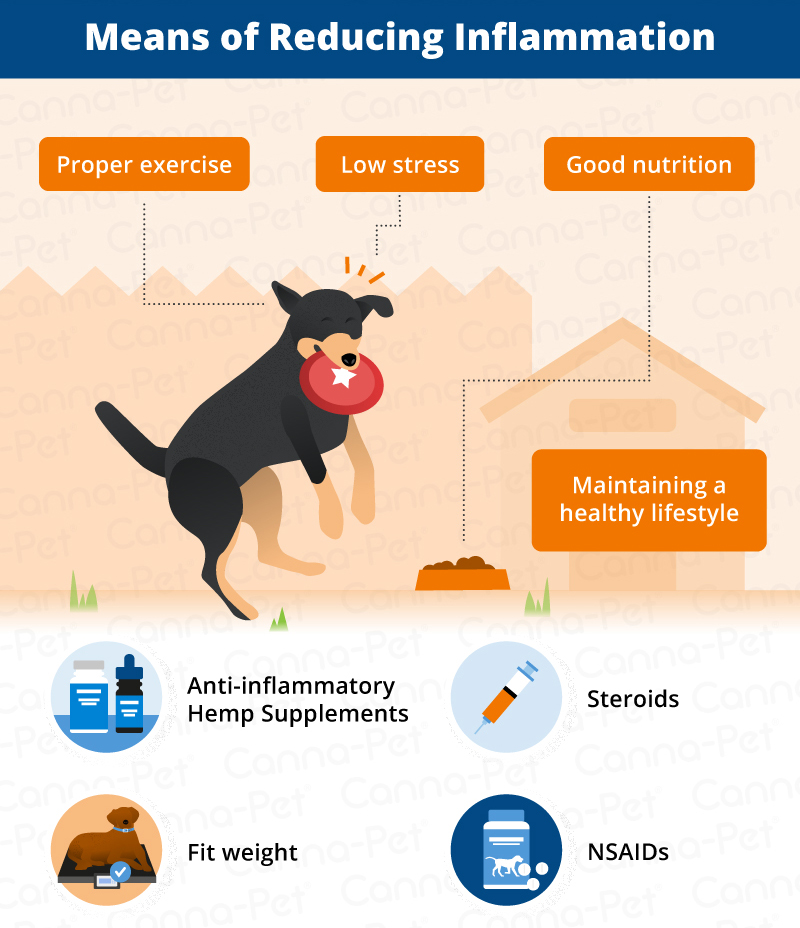Inflammation in Dogs
Dog inflammation is a complex biological response of the dog’s body tissues to harmful stimuli, such as pathogens, damaged cells, or irritants, and is a protective response involving immune cells, blood vessels, and molecular mediators to repair the body.
Just as people may suffer from bronchitis, colitis, arthritis, tonsillitis or a range of other inflammatory (or “itis”) conditions, so too can your dog. Inflammation is the body’s immune response against foreign substances, injuries or infection. It can also result from autoimmune diseases, in which the body triggers an inflammatory response when there aren’t any invaders to battle.
Dog inflammation occurs when plasma and white blood cells are drawn to a part of the body to fight infection, take away dead cells and initiate tissue repair. Increased blood flow to the area causes the region to appear reddened and feel warm. The blood vessels become more permeable, and leak fluid into the surrounding tissue, causing swelling. Chemicals are released into the tissue or blood to fight infection and do other jobs. But inflammation comes with a price: Increased pressure from swelling, along with the release of certain chemicals such as bradykinin and histamine, stimulate nerve endings and cause pain. Anytime you see inflammation, expect that your dog hurts.
In addition, chronic inflammation can predispose your dog to certain diseases, even some types of cancer. And more evidence is compiling that chronic inflammation is far more common than we once thought.
Inflammatory Conditions for Dogs
Sometimes inflammation is obvious. A dog with a recent cut or burn will have inflamed tissue in the injured area; a dog with an ear infection will often have an inflamed ear canal; a dog with periodontal disease will have inflamed gums; a dog with an allergic reaction to fleas will have inflamed skin. Sometimes the inflammation is internal and not so obvious; a dog with an inflamed prostate, pancreas or kidney may be in intense pain, but you can’t see the cause.
Inflammatory disease can be acute or chronic, mild or severe. Some examples:
Arthritis is an especially common condition accompanied by inflammation. The joint becomes filled with extra cells and inflammatory substances, causing irritation, wearing down of the cartilage, swelling of the joint lining, stiffness, and pain. Some, but not all, types of arthritis are thought to be caused by inflammation that has been misdirected. This is less the case in osteoarthritis, in which inflammation may occur in response to damage to the cartilage in the joint.
Asthma is a disease of inflammation caused by the actions of inflammatory cells such as mast cells, eosinophils, neutrophils, T- lymphocytes, epithelial cells, and macrophages. Inflammation of the airways produces the classic symptoms of asthma: coughing, wheezing, chest-tightening, and difficulty breathing.
Inflammatory bowel disease: Inflammation of the stomach or intestinal lining inhibits normal digestion of food and can cause chronic vomiting, long-term diarrhea, weight loss and abdominal pain that may come and go. The underlying cause may be genetic, food allergies, parasites, bacteria or other reasons not yet understood.
Inflammatory joint disease: usually caused by an infection, such as bacterial or fungal infection, tick-borne disease, and Rocky Mountain spotted fever. This type of arthritis can also be caused by an underlying defect in your dog’s immune system, which may be hereditary.
Conjunctivitis: Inflammation of the conjunctiva of the dog’s eye is usually caused by irritants, allergies or dry eye.

Dermatitis: Inflammation of the skin.
Encephalitis: Inflammation of the brain can cause a variety of neurological and behavioral signs, as well as pain. It may also be associated with inflammation of the spinal cord (myelitis) or brain covering (meningitis).
Glomerulonephritis: This inflammatory process in the kidneys can cause chronic kidney failure.
Pancreatitis: Inflammation of the pancreas causes intense pain, with the condition often recurring throughout the dog’s life. It’s most often seen in middle-age or older overweight dogs.
Masticatory muscle myositis: This inflammatory disease of the jaw muscles starts with swelling and pain, and with time leads to atrophy of the jaw muscles.
Panosteitis: This painful inflammation of the long bones is seen in young dogs, usually between 5 and 19 months of age. It affects the front legs more often, and the dog may find it too painful to play. The condition can last from days to months and can be mild or severe.
Uveitis: Inflammation of the eye’s iris and muscles that control the lens can be very painful; it is most often immune-mediated but can be caused by a variety of factors.
Any condition that ends in “itis” refers to inflammation: folliculitis, glomerulonephritis, hepatitis, lymphadenitis, meningitis, and myocarditis are all issues found in dogs directly related to inflammation.
Those aren’t the only kinds of inflammation your dog may have. In truth, many, if not most, types of inflammation tend to fly under the radar and aren’t named as a particular disease condition.
Exercise & Canine Inflammation
Exercising causes inflammation of the muscles. In fact, exercise is an interesting case as regards inflammation. Regular exercise tends to lower markers of systemic inflammation. Acute exercise tends to increase markers of acute inflammation. Repeatedly performing rigorous exercise before inflammation subsides from previous exercise can create a condition of chronic inflammation. The take-home message is to work up to higher levels of exercise gradually, and provide rest times and proper nutrition between periods of intense exercise. That’s essentially what we’ve been told for years to avoid chronic pain; now we know that’s probably because it also avoids chronic inflammation.
The Downside of Inflammation for Dogs
While inflammation is a helpful process combating injuries and invaders, chronic inflammation can also be harmful as it can cause chronic pain and even increase the chances of some diseases. Unfortunately, many, if not most, instances of inflammation may go unnoticed. A virus may enter the gastrointestinal tract and trigger an immune response and inflammatory process. Non-food objects (and what dog doesn’t eat a twig or an occasional illicit snack from the trash?) and even some foods can produce pro-inflammatory molecules.
Many human physicians and researchers now believe the role of inflammation in the creation and proliferation of disease is far greater than previously thought. “Inflammation is the root of cancer, heart disease and brain decline,” says David Agus, M.D., Professor of Medicine and Engineering at the University of Southern California and author of The End of Illness: A Short Guide to a Long Life.
Tanya Edwards, M.D., former Founder and Medical Director of Cleveland Clinic’s Center for Integrative Medicine, writes that inflammation is now recognized as the underlying basis of a significant number of diseases. Research has shown that inflammation plays a role in turning on certain genes that predispose an animal to certain diseases, including cancer. Edwards writes that Alzheimer’s disease, cardiovascular disease and diabetes, among others, may all be related to chronic inflammation in the human body.
Although we know less about the role of inflammation in the dog’s body, it’s reasonable to assume it has the same ill effects on health. And in fact we do know that inflammation is the most common source of aches and pains for all dog breeds, of all ages. See our Breed Guide for more specifics on your pet.
Means of Potentially Reducing Inflammation
Maintaining a healthy lifestyle, with proper exercise, low stress, good nutrition and fit weight are beneficial but can’t help some cases of established inflammation. Steroids can reduce inflammation but are notoriously bad for long-term use. Non-steroidal anti-inflammatories (NSAIDs), while safer, are potentially less effective and still have long-term concerns in both people and dogs.
Pros and Cons of Non-Steroidal Anti-Inflammatory for Dogs (NSAIDs)
Some common non-steroidal anti-inflammatory drugs for dogs are Carprofen, Deracoxib, Firocxib, and Meloxicam. Although NSAIDs can be effective at treating pain and inflammation, they can also cause damage to the joints. Veterinarians should inform patients of the toxicity and risks of NSAIDs, but unfortunately this doesn’t always happen. NSAIDs can damage the liver which can result in dangerous side effects such as ulcers. It’s important to be aware of the signs of liver or kidney damage, but you should also monitor your dog’s liver enzyme levels regularly if usings NSAIDs.
If you choose to use NSAIDs, it’s also crucial that you do thorough research since some medications cannot be mixed with NSAIDs and would cause negative side effects. Visit a veterinarian to be sure that you’re keeping your dog safe and healthy, while still getting effective dog pain relief.
Due to the risks, some pet owners look into natural anti-inflammatory options for dogs. If you’re thinking about taking an alternative approach, talk to your vet to learn more about the various natural anti-inflammatory medications and herbs for dogs.
Anti-Inflammatory Hemp Compounds & Terpenes
There are no less than a dozen natural, plant-based compounds and terpenes that have documented natural anti-inflammatory properties.
Canna-Pet® for Inflammation – Hemp Nutrition
A recent study by Colorado State University found that among those with an opinion, 91.9% of Canna-Pet® customers reported that our hemp products reduced inflammation a moderate amount or a great deal.
Research in animal models indicates both CB1 and CB2 receptors are implicated in inflammatory pain.
Full Dog Inflammation Infographic










